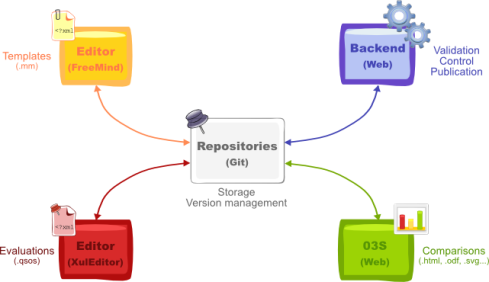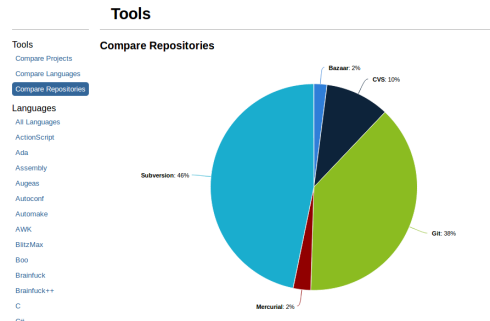Is a useful and easy-to-use tool that extracts statistical information for FLOSS projects out of CVS and Subversion repository logs and transforms it in database SQL formats.
CVSAnalY in the beginning was Gregorio Robles, Grex’s script (cvsanal) ,in 2002 when he was still a PhD student but the main authors was Carlos Garcia Campos .
This tool has a web interface, called CVSAnalYweb, where the results can be retrieved and analyzed in an easy way, CVSAnalYweb had been used in a close environment at university for research purposes.
CVSAnalY has been released under the terms of the GNU General Public License.
Web site: http://metricsgrimoire.github.io/CVSAnalY/
You can extracts this Metrics from the data base :
- Number of developers making changes in the project.
- Number of non-active developers.
- Number of changes made in the project.
- Number of modules present in the project.
- Number of files present in the project.
- Number of files changed in the project.
- Meta-information associated to every commit can be used to reconstruct the modification requests.
- User name of the commiter.
- File (or files in the system supports modification requests) where the changes occurred.
- Date of the change.
- Number of lines added, removed or changed (counted as both added and removed).
- Inspecting the contents of the file or looking at its extension, filetype can be obtained.
- Information about the code ownership.
- Size and complexity measurements (as in version control systems source data).
- Number of commits.
This schema is a bit out of date. This figure was obtained from the deliverable 3.1 in the FLOSSMetricsproject.
Several methods have been created to define an assessment process for free/open-source software. Some focus on some aspects like the maturity, the durability and the strategy of the organisation around the open-source project itself. Other methodologies add functional aspects to the assessment process and other Methodology of Qualification .
I will talk about Methodology of Qualification and Selection of Open Source software (QSOS)
The Qualification and Selection of Open Source software (QSOS) is a methodology for assessing Free/Libre Open Source Software. This methodology is released under the GFDL license.
QSOS is a free project aiming to mutualize and capitalize technological watch on open source components and projects.
QSOS defines 4 steps that are part of an iterative process:
- Define evaluation templates structured as trees of evaluation criteria with two major axis:
* Project’s maturity: criteria fixed and made mandatory by QSOS whatever software family is considered
* Software’s functional coverage: criteria depending on the considered software family
- Evaluate open source solutions against templates by scoring the criteria
- Qualify specific usage contexts by weighting the criteria
- Select most relevant solutions identified through comparisons based on scored and weighted criteria.
QSOS templates and evaluations are formatted in XML.
The following tools are available to manipulate these XML documents.
- Freemind: the famous minmapping tool is used to design evaluation templates
- QSOS Editor: to evaluate an open source solution as soon as a template is available
- QSOS Repositories and Backend: a Web Git-based application to host, manage and share both templates and evaluations
- O3S (Open Source Selection Software): a Web application to manipulate evaluations, create comparisons and export them in several formats.

Ohloh is a public directory of Free and Open Source Software and the contributors who create and maintain it .
Owned and operated by Black Duck Software.
It does not host projects and code. It is actually a directory, a community, and analytic and search services.
By connecting to project source code repositories, analyzing both the code’s history and ongoing updates, and attributing those updates to specific contributors.
By retrieving data from revision control repositories (such as CVS, SVN, Git, Bazaar, and Mercurial), Ohloh provides statistics about the longevity of projects, their licenses (including license conflict information) and software metrics such as source lines of code and commitstatistics
As of 6 July 2013, the site lists 590,310 projects, 538,806 source control repositories, 2,373,936 contributors and 23,457,982,058 lines of code
Ohloh Tools
1. Compare project statistics, including activity, codebase, contributors, and more in either a graphical or side-by-side view .

2. Compare languages based on commits, contributors, lines of code changes, and the total number of new projects .
3. Compare types of repositories based on how many of that type are registered with Ohloh.

Offical Website: www.ohloh.net
In 2002, the first FLOSS survey was launched by a research group based at University Rey Juan Carlos Madrid (libresoft) and after 10 years they replicate the survey in order to see how the community has changed.
The survey opened November 12th 2013 and will close November 29th 2013. We encourage you to spread the word among your community.
So please take a look at this Survey
Why Ubuntu is so more popular than Debian even when they have As many as Ubuntu developers? Even when Ubuntu is largely Debian. So why is it that?
The answer is that its leader, Mark Shuttleworth is a strong leader with a clear vision.
In every project we need strong leader that achieve principle models
I read an article by Rob Hirschfeld I found it very useful of open source leadership .He talked about the principles model in open source leadership in my opinion it will works in every project not just for open source leaders .
Her is summery of his models in leadership for open-source project :
-
Leadership includes service: connecting, education, documentation and testing
- Promotion is a two-edged sword – leaders needs to take extra steps to limit self-promotion or we miss hearing the community voice.
- Collaboration with other leaders.
- Vision must be articulated, but shared in a way that leaves room for new ideas and tactical changes.
- Announcements should be based on available capability not intention. In open source, there is less need for promises and forward-looking statements because your actions are transparent.
- Activity should be visible , it’s the essence of collaboration.
- Testing is essential because it allows other people to join with reduced risk.
- Docs are essential because it reduces friction for users to adopt.
- Upstreaming (unlike Forking) is a team sport so be prepared for some give-and-take.
- It’s not just about code, open source is about solving shared problems together.
Here’s a summary of all the lessons learned according to the author Eric Raymond in his book “The Cathedral and the Bazaar”.
1. Every good work of software starts by scratching a developer’s personal itch.
2. Good programmers know what to write. Great ones know what to rewrite (and reuse).
3. “Plan to throw one away; you will, anyhow.”
4. If you have the right attitude, interesting problems will find you.
5. When you lose interest in a program, your last duty to it is to hand it off to a competent successor.
6. Treating your users as co-developers is your least-hassle route to rapid code improvement and effective debugging.
7. Release early. Release often. And listen to your customers.
8. Given a large enough beta-tester and co-developer base, almost every problem will be characterized quickly and the fix obvious to someone
9. Smart data structures and dumb code works a lot better than the other way around.
10. If you treat your beta-testers as if they’re your most valuable resource, they will respond by becoming your most valuable resource
11. The next best thing to having good ideas is recognizing good ideas from your users. Sometimes the latter is better.
12. Often, the most striking and innovative solutions come from realizing that your concept of the problem was wrong
13. “Perfection (in design) is achieved not when there is nothing more to add, but rather when there is nothing more to take away.”
14. Any tool should be useful in the expected way, but a truly great tool lends itself to uses you never expected.
15. When writing gateway software of any kind, take pains to disturb the data stream as little as possible—and never throw away information unless the recipient forces you to!
16. When your language is nowhere near Turing-complete, syntactic sugar can be your friend.
17. A security system is only as secure as its secret. Beware of pseudo-secrets.
18. To solve an interesting problem, start by finding a problem that is interesting to you.
19. Provided the development coordinator has a communications medium at least as good as the Internet, and knows how to lead without coercion, many heads are inevitably better than one.
The world’s first computer programmer is an English mathematician and writer Ada Lovelace (1815 –1852)
Known for her work on Charles Babbage’s early mechanical general-purpose computer her notes on the Analytical Engine include what is recognized as the basic algorithm for the modern programming languages The computer language Ada was named after Ada Lovelace.
This is the first seed where the women had role in the programming.
And now for the open source women ,at 2002 survey according to the ”http://www.flossproject.org/report/FLOSS_Final4.pdf ” of open source communities found that approximately 1.40 % of contributors were women. Overall the percentage of women accepted has slowly but surely increased every year for example in google summer code the number increased since 2006.
In theprevious post slideshow some of these women who had leadership in the open source community.
What is web-based software? Web-based software is software you can use over the internet with a web browser. You don’t have to install or download any software, or worry about upgrades.
Here we will talk about the Web-Based Project Management Software: it is not just for managing software based project.The web-based software provide tools for planning, organizing and controlling resources to achieve project goals and objectives.
In the following list some of the best open source project management web-based tools used by some of the biggest research organizations and companies.
Codendi
Codendi is an open-source collaborative development platform offered by Xerox. From only one interface, it gathers, all the needed tools for software development teams: management and versioning of code, bugs, requirements, documents, reporting, tests etc. It is mainly used for managing software project processes.
Redmine
Redmine is a flexible project management web application. Written using Ruby on Rails framework, it is cross-platform and cross-database. It includes calendar and gantt charts to aid visual representation of projects and their deadlines.
ProjectPier is a Free, Open-Source, self-hosted PHP application for managing tasks, projects and teams through an intuitive web interface. ProjectPier will help your organization communicate, collaborate and get things done Its function is similar to commercial groupware/project management products, but allows the freedom and scalability of self-hosting.
Trac
Trac is an open source, web-based project management and bug-tracking tool. Trac allows hyperlinking information between a computer bug database, revision control and wiki content. It also serves as a web interface to a version control system like Subversion, Git, Mercurial, Bazaar and Darcs.
Collabtive is a web-based project management software that is being published as Open Source software. The project was started in November 2007. It strives to provide an Open Source alternative to proprietary tools like Basecamp or ActiveCollab. Collabtive is written in PHP and JavaScript.
Collabtive web site
Feng Office (formerly OpenGoo )
It is a complete online solution focused on improving productivity, collaboration, communication and management OpenGoo main features include document management, contact management, e-mail, project management, and time management. Text documents and presentations can be created and edited online. Files can be uploaded, organized and shared, independent of file formats.
ClockingIT
ClockingIT is an application for tracking tasks, issues, projects and time spent, Plan projects, schedule with a focus on software development and handling large amounts of tasks.

















